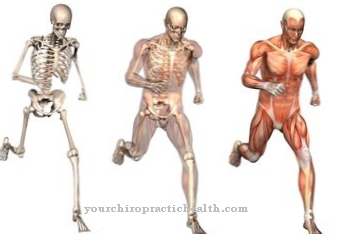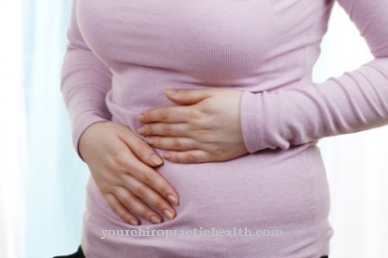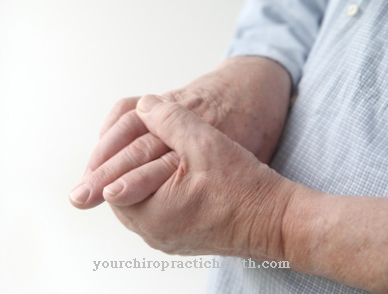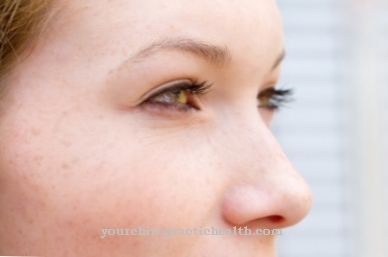In most cases it is yellow bowel movements harmless, but it also occurs as an accompanying symptom of various diseases.
What is yellow stool?

Most of the stool consists of water, but it also contains mucus, fermentation products of bacteria, rejected cells from the intestinal mucosa and food components that are not digested.
The condition of the stool depends very much on the food consumed. Usually it is pulpy and has a brown color. However, different diseases can cause the bowel movement to take on a different texture or color. In addition to black, red-brown or discolored stools, a distinction is also made between yellow and light-colored stools, with light-colored stools very often indicating diseases of the bile, liver or pancreas.
A yellow coloration of the stool is usually harmless, but there are transitional forms in which a doctor should be consulted to clarify whether there is no serious illness. Especially if symptoms such as diarrhea occur, the yellow coloration could be due to a disorder.
causes
If yellow bowel movements occur without any accompanying symptoms, the cause is usually harmless. In this case, the yellow color could have been caused by the ingestion of certain foods such as eggs, dairy products or starchy foods.
Especially in babies, yellow stools occur very often due to the diet with breast milk. In addition, the stool often turns yellow even with diarrhea. The yellowish color is caused by the so-called Sterkobilin, a breakdown product of hemoglobin that also turns the urine yellow. A yellowish-greasy bowel movement can be caused, for example, by an absorption disorder such as celiac disease.
Yellowish diarrhea is also caused by so-called giardia, parasites that can be found in contaminated water or waste products. In this case, the diarrhea is accompanied by flu-like symptoms and a fever. Yellow diarrhea can also be caused by cholestasis, a condition that reduces the amount of bile released.
A decrease in the bile fluid also occurs with gallstones or gallbladder inflammation. Clay-yellow stools that are associated with yellowing of the conjunctiva or skin can also indicate jaundice or hepatitis. It is also possible that a disease of the pancreas leads to a yellow coloration of the stool, whereby abdominal tumors in particular can be the cause.
You can find your medication here
➔ Medication for diarrheaDiseases with this symptom
- Celiac disease (gluten intolerance)
- hepatitis
- Food intolerance
- Cholestasis
- Jaundice
- Cirrhosis of the liver
- Gallstones
- Gallbladder inflammation
- Inflammation of the pancreas (pancreatitis)
Diagnosis & course
Home remedies ↵ for diarrhea If yellow stool is accompanied by symptoms such as abdominal pain, diarrhea, vomiting, nausea or extreme tiredness, a doctor should be consulted who will clarify the possible causes using a differential diagnosis.
Especially if you are very tired, the yellow color could also be due to liver disease. If the bile ducts are blocked, the pigments can no longer be completely passed into the intestines, which leads to yellow stools. If yellow stools appear, the doctor will first record the medical history. These include, for example, existing allergies, gastrointestinal diseases, food intolerances or disorders of the pancreas, liver or bile.
A possible suspected diagnosis is then clarified through special laboratory tests, such as blood counts and stool samples. With the help of a stool sample, the stool can be examined for possible pathogens, whereby the pathogen is detected under a microscope or in the culture. The stool is usually taken on three different days, as this enables the doctor to increase the reliability of the detection of possible pathogens. Even if yellow stools are harmless in most cases, serious illnesses should still be ruled out.
Complications
When designating the complication, the guilty disorder should be considered. A complication in medicine is a later symptom of a health disorder or a side effect of a drug that is used against the disorder in question. Complications can therefore arise as a result of a misdiagnosis and in the course of treatment. Yellow stool is a complication of liver disease or diarrheal disease, which are diseases of the digestive tract.
Yellow bowel movements result from bacterial infections or biliary stasis, which are sometimes promoted by fatty or contaminated food. Complications usually arise in pre-stressed patients. Yellow bowel movements can be a harbinger of dangerous liver or biliary disease, especially when added to other symptoms. In order to prevent dangerous complications, an examination should be scheduled if unclear symptoms appear. At times, the patient should be evaluated in a hospital to avoid complications such as yellow bowel movements.
The concept for the subsequent outpatient procedure against yellow stool or the causative disease can be determined here. Yellow stool itself is not a disease, but a complication of symptoms caused by liver disease. Eating healthy food, avoiding high-fat foods, and regular health checkups can prevent yellow bowel movements. Sometimes a diet is recommended. Some drugs are dangerous to the digestive organs, which is why they should be omitted if the stool is yellow.
When should you go to the doctor?
A yellow stool color is nothing unusual in itself and is usually harmless. Yellow stool is not a key symptom of certain diseases and only in a few cases indicates a serious illness. If there are no further symptoms, you can first wait. If, on the other hand, the yellow discoloration is accompanied by other symptoms such as diarrhea, nausea and vomiting, abdominal cramps, fever or extreme tiredness, the doctor should be consulted to clarify the cause.
Especially if you are extremely tired, the yellow stool may be due to a liver disease, which should always be clarified. For example, if the bile ducts are blocked, dye can only reach the intestine to a limited extent. This can lead to completely discolored or yellowish stools.
In addition, a doctor should be consulted if the change in color of the stool persists for several weeks or months. If the discoloration does not go away due to changes in eating habits, tests should be carried out to rule out serious illnesses. In children, too, yellow stools can initially be observed in the absence of other symptoms. In babies, a golden-yellow stool color is normal and can be traced back to breast milk (so-called milk stool).
Doctors & therapists in your area
Treatment & Therapy
If a yellow stool is triggered by an illness, therapy is necessary. Most of the time, the color of the stool changes due to a change in eating habits.
In other cases, the underlying disorder is treated, primarily diarrhea, which occurs due to various causes. Here, for example, activated charcoal helps to stop the diarrhea again. Electrolyte or fluid replacement may also be necessary. There are special solutions for this with glucose and table salt. Antibiotics are only used for bacterial infections. If food intolerances are the cause of the yellow coloration, they must be avoided.
It is more difficult with pancreatic, biliary or liver diseases. In the case of gallstones, surgery may then be necessary; in the case of hepatitis, treatment depends on the type of hepatitis, as hepatitis A, D and E usually heal on their own. Chronic hepatitis B and C is treated with antiviral drugs that stop the infection. However, the stool here is mostly clay-colored or even colorless, yellow bowel movements are extremely rare.
Outlook & forecast
In most cases, yellow stool is a harmless symptom that often occurs as a side effect of an illness. In many cases, the yellow stool can also be triggered by a drug, which must be changed or discontinued after consulting a doctor.
If the symptom is related to a disease of the liver or bile, treatment by a doctor is also advisable. If the pain is very severe, outpatient care is necessary. In general, a healthy lifestyle with a healthy diet can have a positive effect on digestion and therefore yellow stool. The yellow color itself is not a complication.
If the yellow stool occurs due to inflammation or an infection, drugs and antibiotics are usually used to treat the symptom. There will be an improvement after a few days. In most cases, however, a change in diet or omitting certain ingredients and medications that lead to yellow stool is enough. However, it is advisable to always consult a doctor about this.
You can find your medication here
➔ Medication for diarrheaprevention
Since yellow stool is usually not a disease, recommendations for prevention are hardly possible. Certain foods have an important influence on the color of the stool, so it is highly recommended that you eat a balanced diet.
You can do that yourself
Yellow stools are usually harmless and do not require medical treatment. Various home remedies and measures regulate the color and consistency of the stool. It is usually sufficient to remove products and dairy products that contain a lot of protein from the menu, as these will turn the stool yellow. If this does not restore the natural color of the stool, there may be an upset of the gastrointestinal tract.
Tried and tested home remedies for constipation, diarrhea and the like are bed rest, drinking a lot and avoiding irritating foods. A complaint diary can also be created to record the type and severity of symptoms. In addition to medical treatment, we recommend high-fiber natural remedies such as olive oil, konjac powder or dried figs. An intestinal enema helps with constipation and flushes possible toxins out of the gastric dark tract.
Yellowish stool, which is associated with severe diarrhea and the typical flu symptoms, indicates a parasite infestation (Giardia). Effective home remedies include garlic, wormwood, oregano or annual mugwort. Cloves, thyme and goosefoot can also be drunk as tea and promise quick relief from the symptoms. Yellow bowel movements associated with nausea, abdominal pain, or chronic fatigue should be clarified by a doctor.



.jpg)


.jpg)

.jpg)



















